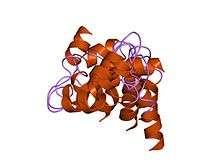Poneratoxin
| Poneratoxin | |
|---|---|
| Identifiers | |
| Symbol | ? |
| SCOP | 1G92 |
| SUPERFAMILY | 1G92 |
| OPM superfamily | 160 |
| OPM protein | 1g92 |

Poneratoxin is a paralyzing neurotoxic peptide from the bullet ant Paraponera clavata that affects voltage-dependent sodium ion channels and blocks the synaptic transmission in the central nervous system. Poneratoxin becomes insoluble when it is transferred from the cytoplasm of the cell into the cellular membrane.[1] Poneratoxin is being studied for its uses in biological insecticides. It is through the use of a recombinant poneratoxin-producing baculovirus that poneratoxin's biological properties are being studied.[2]
Function
Poneratoxin blocks nicotinic synaptic transmission in the central nervous system of insects, while also affecting voltage gated sodium channels. It depolarizes large interneurons while also acting as a strong, but slowly acting agonist for smooth muscles.[3]
Structure
The poneratoxin peptide is stored in an inactive 25-residue peptide in the venom reservoir. It has a V shape, along with two αlpha helices connected by a βeta turn.[4] The two αlpha helices, however, have different characteristics. The first helix is apolar, while the second helix contains polar and charged amino acids, which results in different interactions with regards to cellular membranes. The extremely hydrophobic N-terminal αlpha helix will react with uncharged lipid bilayers composed of phosphatidylcholine easily, whereas the C-terminal αlpha helix, which is terminating with arginine and slightly positive, will be able to attach to negatively charged cell surfaces.[5] Researchers also noted that the poneratoxin sequence begins with a hydrophobic phenylalanine, which plays an important role in membrane penetration and that native poneratoxin does not contain cysteine.[6]
See also
References
- ↑ "http://onlinelibrary.wiley.com/store/10.1111/j.1432-1033.2004.04128.x/asset/j.1432-1033.2004.04128.x.pdf;jsessionid=4EEA1A70E5806F0083266E6E9CCA0DFC.f03t02?v=1&t=iv8dnye2&s=3ac9bc46461ba4b18cb8f9804177b7e766191ecc" (PDF). doi:10.1111/j.1432-1033.2004.04128.x/asset/j.1432-1033.2004.04128.x.pdf;jsessionid=4eea1a70e5806f0083266e6e9cca0dfc.f03t02. External link in
|title=(help) - ↑ Touchard, Axel; Aili, Samira R.; Fox, Eduardo Gonçalves Paterson; Escoubas, Pierre; Orivel, Jérôme; Nicholson, Graham M.; Dejean, Alain (2016-01-20). "The Biochemical Toxin Arsenal from Ant Venoms". Toxins. 8 (1). doi:10.3390/toxins8010030. ISSN 2072-6651. PMC 4728552
 . PMID 26805882.
. PMID 26805882. - ↑ Hendrich, Andrzej B.; Mozrzymas, Jerzy W.; Konopińska, Danuta; Scuka, Maria (2002-01-01). "The effect of poneratoxin on neuromuscular transmission in the rat diaphragm". Cellular & Molecular Biology Letters. 7 (2): 195–202. ISSN 1425-8153. PMID 12097919.
- ↑ www.toxno.com.au. "Poneratoxin | CASRN: 137084-94-7 | Toxic Chemicals in Food, Cosmetics, Home, Workplace". www.toxno.com.au. Retrieved 2016-11-15.
- ↑ Szolajska, Ewa; Poznanski, Jaroslaw; Ferber, Miguel López; Michalik, Joanna; Gout, Evelyne; Fender, Pascal; Bailly, Isabelle; Dublet, Bernard; Chroboczek, Jadwiga. "Poneratoxin, a neurotoxin from ant venom". European Journal of Biochemistry. 271 (11): 2127–2136. doi:10.1111/j.1432-1033.2004.04128.x.
- ↑ Szolajska, Ewa; Poznanski, Jaroslaw; Ferber, Miguel López; Michalik, Joanna; Gout, Evelyne; Fender, Pascal; Bailly, Isabelle; Dublet, Bernard; Chroboczek, Jadwiga. "Poneratoxin, a neurotoxin from ant venom". European Journal of Biochemistry. 271 (11): 2127–2136. doi:10.1111/j.1432-1033.2004.04128.x.
External links
- Antinociceptive effect of poneratoxin (PoTX) in rats. Pestycydy, 2008, (1-2), 135-141. ISSN 0208-8703
- Gerritsen, Vivienne Baillie (September 2001). "Princess Bala's sting". Protein Spotlight (14). ISSN 1424-4721.
- Szolajska, Ewa; Poznanski, Jaroslaw; Ferber, Miguel López; Michalik, Joanna; Gout, Evelyne; Fender, Pascal; Bailly, Isabelle; Dublet, Bernard; Chroboczek, Jadwiga (2004). "Poneratoxin, a neurotoxin from ant venom. Structure and expression in insect cells and construction of a bio-insecticide". Eur. J. Biochem. 271 (11): 2127–2136. doi:10.1111/j.1432-1033.2004.04128.x. PMID 15153103.